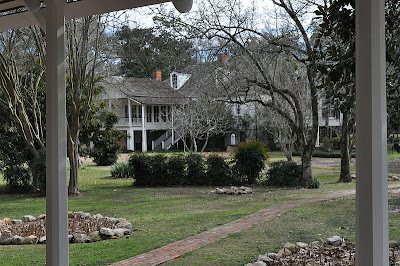We've been enjoying the local restaurant scene and have eaten some really good Southern/Cajun food during our time here. Soft shell crab at Ernest's Orleans Restaurant, crawfish etoufee at Ralph & Kacoo's, fried crawfish at Copeland’s, more fried catfish at Jan's River Restaurant, and some killer shrimp po-boys at Sam's Seafood have been just a few. Some of these meals were enjoyed with family and friends and others were just the two of us. In addition, we’ve had family over for dinner a few times in the new rig.
Recently we met my brother, Joe, for Sunday Mass at a church built in the 1800’s. After Mass we headed off to St. Joseph’s Cemetery (one of the city’s oldest) for a memorial service for the priests buried there. Three of the graves are priests that died in the 1873 yellow fever epidemic. We wandered around a bit, looking at headstones from the 1800’s and imagining life at that time. So many of the graves were for children and young adults. After the service it was off to one of the favorite activities in the good food South…eating lunch! This time it was at El Chico’s, one of the oldest Mexican restaurants in town.
Grave of Fr. Biler, yellow fever victim
Joe, waiting for his enchiladas
Friday we picked up my dad bright and early and the three of us headed south to Natchitoches, LA to spend a day playing tourist. It was a beautiful, crisp and cool morning with a spectacular sunrise.
Louisiana sunrise
For those unfamiliar with Louisiana history, Natchitoches was founded in 1714 as a French fort to prevent the Spanish from advancing from Texas into Louisiana and to set up trading with the Caddo Indians. There was a Spanish mission and fort at Los Adaes, around 15 miles to the west, which ended up being one of the biggest trading partners with the French fort - how ironic. Guess that’s what happens when you are the only two outposts for a couple of hundred miles in any direction.
We ate breakfast at Lasyone’s (pronounced Laz-ons), the home of the original Natchitoches meat pie, a local favorite food, spicy hamburger meat in pastry. We followed that by some time at Fort St. Jean Baptiste. The original fort has long since rotted away in the Louisiana humidity, but there is a full-scale replica based on the original engineer’s plans that were found in France. We got a private tour by a state park employee, as things were quiet that morning.
Lasyone’s Restaurant
Palisade at Fort St. Jean Baptiste
Daddy and Heinz discussing the fort’s terrain
Daddy and Heinz in front of African House. The corner posts were not originally part of the structure, but the roof was damaged by Hurricane Rita and are now necessary until repairs can be completed.
The “big house” from the porch of Yucca House.
In 1884, Melrose Plantation was bought by the Henry family. “Miss Cammie” (wife of the owner), made Melrose a haven for artists and writers. In the 1930’s, a woman who was a cook at the plantation found some paints in the trash and asked if she could have them. Thus started the painting career of one of America’s best-known primitive artists, Clementine Hunter. The plantation still owns many of her paintings. The upper floor of the African House is home to several murals that she did for the Henry family.
Baptismal scene
Monday washday
Field work and Church
250 year old live oaks on the plantation
We have also taken advantage of some of the prolific pecan trees in the area. It’s pecan season and Barksdale AFB has some fine trees located in public areas. Therefore, we have spent some time crawling around picking up pecans. So far we’ve shelled about six quart bags and have at least half that many more waiting to be shelled. At the price of pecans there may have to be another trip over to the trees in store for us before we leave town!
Our friends of the day - pecans, pecans, and more pecans!
It's work, but worth the outcome!














No comments:
Post a Comment